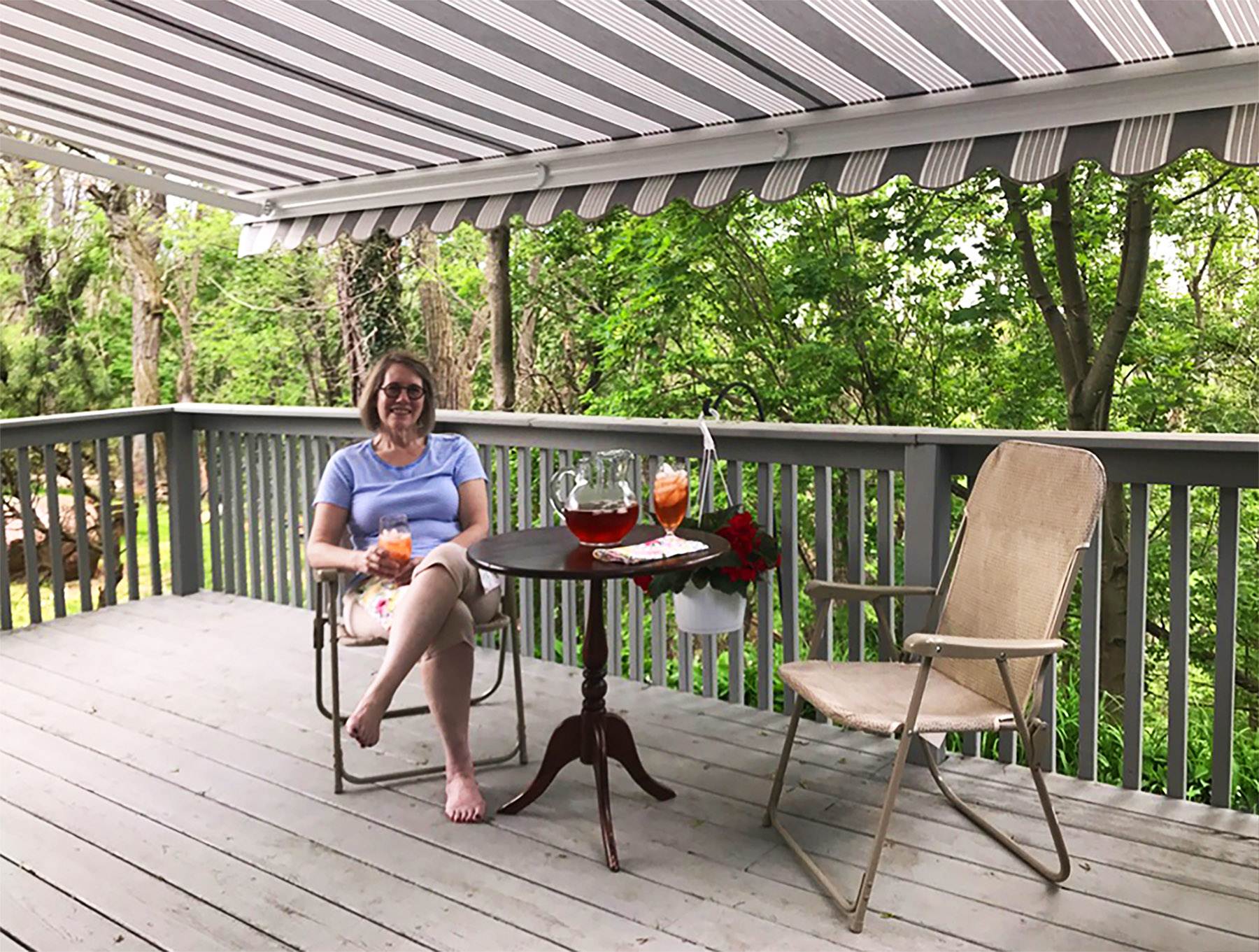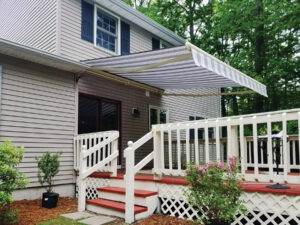
As a lover of outdoor spaces and a frequent host of backyard barbecues, I can’t tell you how many times my electric awning has been the unsung hero during unexpected rain showers. I still remember one particular summer afternoon; the sky suddenly turned grey just as my family was sitting down for a grilled feast. Thanks to our electric awning, the party continued uninterrupted despite the downpour! This got me wondering about the safety of using electric awnings in the rain, and so I decided to delve deeper into this topic.
Electric awnings have revolutionized how we enjoy our outdoor spaces, providing convenient and automated shade at the touch of a button. However, a common question among homeowners, like me, is whether using an electric awning in the rain is safe. This blog will explore the considerations and safety measures to determine if you ca
n use an electric awning during wet weather conditions.
The Advantages of Electric Awnings: Before delving into using electric awnings in the rain, let’s briefly highlight their advantages:
- Convenient Operation: Electric awnings offer effortless control, allowing you to quickly extend or retract the awning.
- Customizable Features: Many electric awnings have programmable settings, automatic sensors, and remote control options for convenience.
- Versatile Use: Electric awnings are suitable for various outdoor spaces, including patios, decks, balconies, and even commercial establishments.
- Energy Efficiency: By providing shade, electric awnings help reduce indoor temperatures, potentially saving energy on cooling costs.
- Increased Lifespan: Proper usage and maintenance of electric awnings can extend their lifespan, ensuring long-term benefits for homeowners.
Using an Electric Awning in the Rain: The Pros and Cons
Pros:
- Instant Rain Protection: One of the significant benefits of electric awnings is that they provide instant cover during unexpected rain showers. With a quick press of a button, you can seek shelter and protect your outdoor living furniture and other belongings.
- Preventing Water Pooling: Electric awnings are designed with a slope to allow rainwater to run off, preventing water pooling and potential damage to the fabric or frame.
Cons:
- Potential Fabric Damage: While modern awning fabrics are water- and mold-resistant, extended exposure to heavy rain can still lead to wear and tear. Excessive rainwater can saturate the fabric and may require adequate drying to maintain its integrity.
- Wind and Gusts: Rain showers are often accompanied by gusts of wind. Leaving an electric awning extended during heavy wind can put stress on the awning’s components and may lead to damage if not adequately secured.
- Awnings and Downspouts: Care should be taken to ensure that the awning is not installed directly under roof downspouts, as it may redirect large amounts of water onto the awning, leading to potential issues.
Safety Tips for Using an Electric Awning in the Rain:
- Monitor the Weather: Stay vigilant about the weather forecast and retract the awning when heavy rain or strong winds are expected.
- Regular Maintenance: Conduct routine inspections and maintenance to ensure the awning remains in optimal condition and performs well in all weather conditions.
- Proper Pitch: Ensure that the awning’s slope is set correctly to allow rainwater to flow off and prevent pooling.
- Prompt Drying: If the awning gets wet during rain, make sure to retract and dry it as soon as possible to prevent fabric damage and mold growth.
Using a motorized awning in the rain can be a convenient way to seek shelter from sudden showers and protect your outdoor space. However, it’s essential to exercise caution and use common sense to ensure the awning’s longevity and safety. Monitoring the weather, regular maintenance, proper pitch, and prompt drying are crucial in making the most of your electric awning and enjoying its benefits in various weather conditions. Remember, a well-maintained automated awning can enhance your outdoor experience, providing shade and comfort for years.
Electric awnings have revolutionized how we enjoy our outdoor spaces, providing convenient and automated shade at the touch of a button. However, a common question among homeowners, like me, is whether using an electric awning in the rain is safe. This blog will explore the considerations and safety measures to determine if you can use an electric awning during wet weather conditions.
The Advantages of Electric Awnings: Before delving into using electric awnings in the rain, let’s briefly highlight their advantages:
- Convenient Operation: Electric awnings offer effortless control, allowing you to quickly extend or retract the awning.
- Customizable Features: Many electric awnings have programmable settings, automatic sensors, and remote control options for convenience.
- Versatile Use: Electric awnings are suitable for various outdoor spaces, including patios, decks, balconies, and even commercial establishments.
- Energy Efficiency: By providing shade, electric awnings help reduce indoor temperatures, potentially saving energy on cooling costs.
- Increased Lifespan: Proper usage and maintenance of electric awnings can extend their lifespan, ensuring long-term benefits for homeowners.
Using an Electric Awning in the Rain: The Pros and Cons
Pros:
- Instant Rain Protection: One of the significant benefits of electric awnings is that they provide instant cover during unexpected rain showers. With a quick press of a button, you can seek shelter and protect your outdoor living furniture and other belongings.
- Preventing Water Pooling: Electric awnings are designed with a slope to allow rainwater to run off, preventing water pooling and potential damage to the fabric or frame.
Cons:
- Potential Fabric Damage: While modern awning fabrics are water- and mold-resistant, extended exposure to heavy rain can still lead to wear and tear. Excessive rainwater can saturate the fabric and may require adequate drying to maintain its integrity.
- Wind and Gusts: Rain showers are often accompanied by gusts of wind. Leaving an electric awning extended during heavy wind can put stress on the awning’s components and may lead to damage if not adequately secured.
- Awnings and Downspouts: Care should be taken to ensure that the awning is not installed directly under roof downspouts, as it may redirect large amounts of water onto the awning, leading to potential issues.
Safety Tips for Using an Electric Awning in the Rain:
- Monitor the Weather: Stay vigilant about the weather forecast and retract the awning when heavy rain or strong winds are expected.
- Regular Maintenance: Conduct routine inspections and maintenance to ensure the awning remains in optimal condition and performs well in all weather conditions.
- Proper Pitch: Ensure that the awning’s slope is set correctly to allow rainwater to flow off and prevent pooling.
- Prompt Drying: If the awning gets wet during rain, make sure to retract and dry it as soon as possible to prevent fabric damage and mold growth.
Using a motorized awning in the rain can be a convenient way to seek shelter from sudden showers and protect your outdoor space. However, it’s essential to exercise caution and use common sense to ensure the awning’s longevity and safety. Monitoring the weather, regular maintenance, proper pitch, and prompt drying are crucial in making the most of your electric awning and enjoying its benefits in various weather conditions. Remember, a well-maintained automated awning can enhance your outdoor experience, providing shade and comfort for years.









